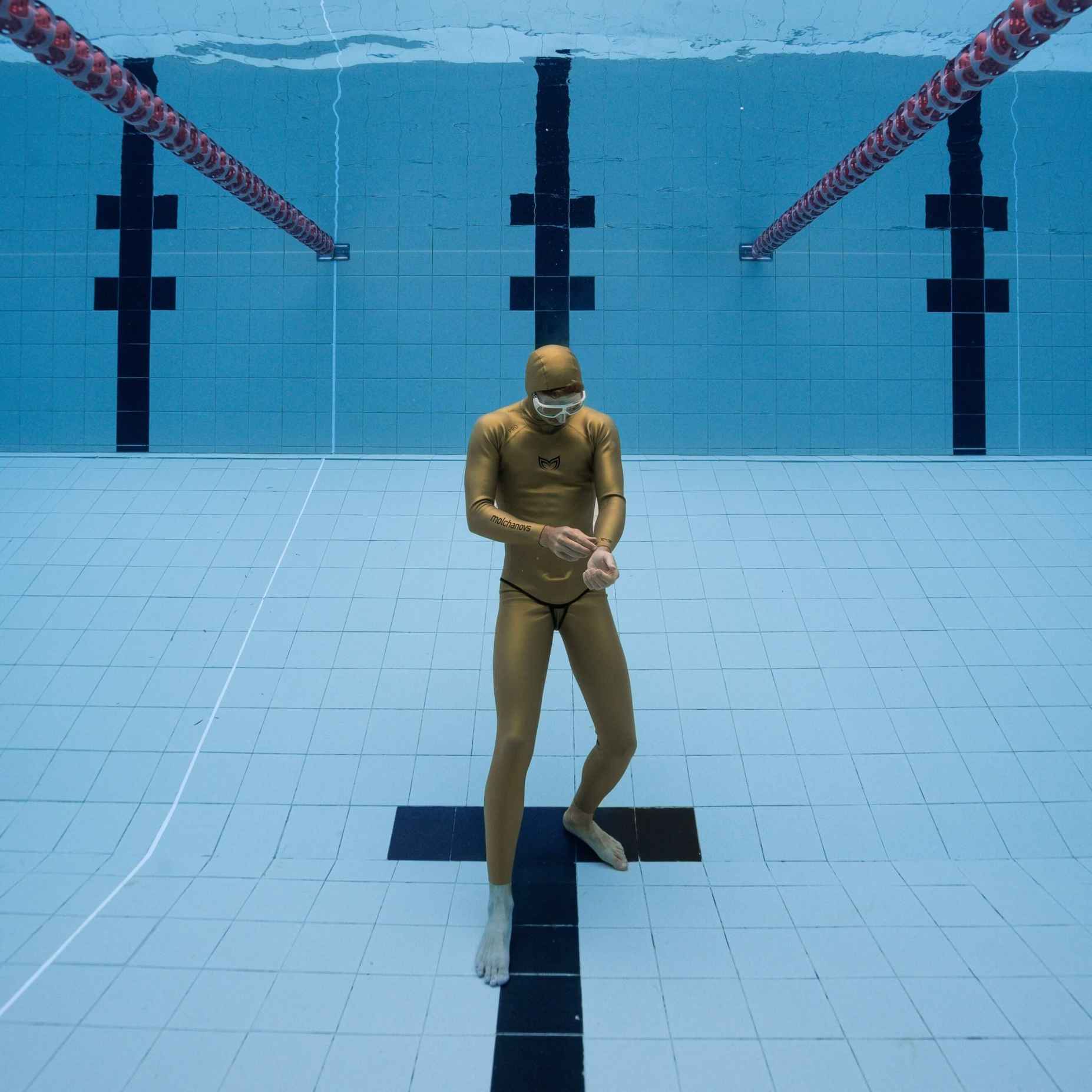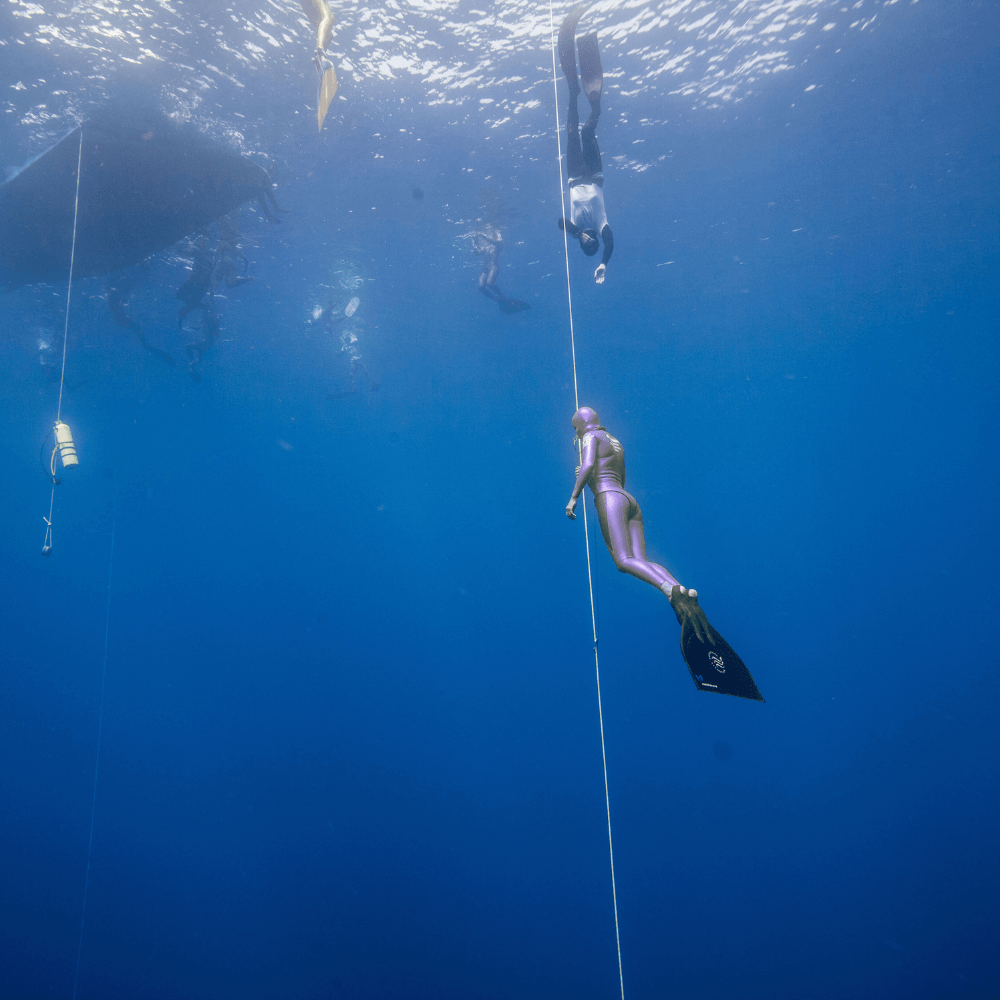Advanced Equipment for Freediving

By Kristina Zvaritch
Contributors: Oli Christen and Alexey Molchanov
As a freediver progresses on their freediving journey, the list of equipment they need tends to grow. Freediving certification courses slowly introduce you to deeper depths and fill you with more knowledge and safety information, but you might need some more equipment to reach those depths safely. Along with the basic equipment a freediver needs, what other gear might you need to consider purchasing in the future?
Advanced freediving equipment includes performance wetsuits, bifins, monofins, nose clips, fluid/self-equalizing goggles, freediving-specific dive computers, freediving floats, dive lines, lanyard stoppers, pulley systems, safety lanyards, CNF belts, and neck weights. For training sessions with another certified freediver, a freediving float, dive line, lanyard stopper, pulley system, and safety lanyard are needed for a safe training session. Continue reading for more information and consider taking a Molchanovs Wave 3 / Lap 3 course for even further specifics on advanced freediving equipment.

Photo by @daanverhoevenfreediver
Performance wetsuit
Wearing a wetsuit while freediving is generally recommended in order to keep warm and to have protection from the sun and stinging creatures in the water. However, performance wetsuits made specifically for freediving can make a big difference. Freediving-specific wetsuits have neoprene that is made to withstand compression at depth (unlike surf suits), yet offer more flexibility and elasticity (unlike scuba suits).
Freedivers have many choices when it comes to choosing freediving wetsuits (check out our in-depth wetsuit guide). Generally, training wetsuits with single-lining outside (open cell inside) significantly reduce heat loss and are preferred among recreational freedivers to use for training as they are more durable than competition wetsuits.
Performance wetsuits with no lining (also known as “smooth skin open cell”) or single-lining inside (smooth skin outside) can make you glide easier through the water and are excellent for competition. A greater amount of care needs to be taken with both types of wetsuits when donning and removing them, as they are more fragile than double-lined nylon wetsuits.
Take a look at Molchanovs SPORT wetsuits for freediving training or PRO wetsuits for competition here.
Bifins
While many people start out with plastic fins for freediving, as they are cheaper and more durable, they may be too stiff for forming good technique. It is recommended to get rubber or silicone fins for training technique, and then to upgrade to fiberglass or carbon fiber fins for performance. Fiberglass fins offer more options for stiffness and are more efficient than plastic, but are also a bit more delicate. Top athletes generally prefer carbon fiber fins for their efficiency, although more care needs to be taken when handling and traveling with them, as they are quite fragile. You can purchase blade tips to protect your bifin blades when in transit.
We recommend Molchanovs CORE Silicone Bifins for training and traveling. For fiberglass, our top pick is the PRO Hyper Fiberglass bifins, while we recommend the PRO Hyper Carbon bifins for those who are in the market for carbon fiber fins.
Monofin
The monofin is a type of large, single fin that is used as an alternative to bifins. It requires a dolphin kick technique, and once this technique is mastered, the freediver has increased power that can take them deeper and further than bifins. Monofin technique can be developed with rubber fins, and is introduced to freedivers in the Molchanovs Lap/Wave 2 course and trained further in the Lap/Wave 3 course.
Monofins are generally made from carbon fiber, fiberglass, or carbon composite. Carbon fiber blades are flexible, lightweight, and energy efficient, but are more expensive and fragile. Fiberglass blades are a bit heavier but are still thin, light, responsive, and more durable. Carbon composite blades include both fiberglass and carbon fiber. Blades come in different stiffnesses, but generally a softer blade is preferred to save energy. When traveling, take care to pack a monofin very carefully to protect the blade, or consider purchasing the Molchanovs Hard Case for peace of mind during transit.
A monofin blade is glued to foot pockets that are usually made from rubber, neoprene, or sometimes plastic. Foot pockets should be tight for energy transfer to be more efficient. Too much room in the foot pocket can also cause blistering of the feet. Foot pockets should be flexible and comfortable and come in standard sizes or custom sizes.
Check out the record-breakingMolchanovs PRO Monofin 4 Fiberglass and PRO Monofin 4 Carbon used by top freediving athletes.

Photo by @evsychev
Short carbon bifins
While long bifins give freedivers power and performance, short bifins definitely have a place in your gear bag. Short carbon bifins are shorter than traditional freediving fins, but are still snappy, responsive, and give you plenty of power due to the carbon blade. For freediving instructors and underwater photographers, short carbon fins are ideal as they are easier to maneuver underwater than long bifins. Frequent travelers who need more compact equipment for easy transit will also love the packability of short fins.
Check out the Molchanovs PRO Short Bifins 2 and see how easy they are to travel with for yourself!
Nose clip
As you approach deeper depths or start to put more focus on Constant Weight No-Fins (CNF) or monofin diving, you will most likely feel that having to put your fingers to your nose to equalize is a hindrance. Nose clips can completely change your style of freediving as you will be able to equalize hands-free and focus more on streamlining and relaxation. They can also help with relaxation as the feeling of water passing over the sensitive nerve receptors around the eyes (which are usually covered by a mask) feels very calming and soothing.
Nose clips are made various materials like aluminum or plastic and come in many different shapes and sizes. They should with a strap that goes around your neck and can be shortened to avoid losing it in between dives. The most important aspect of a nose clip is finding one that has pads that perfectly fit your nose. It is essential to try your desired model on and attempt equalizing with it, preferably in water, and verify that it does not leak or slip.
With a nose clip, you are unable to wear a mask, and you will have to decide whether you want to dive without a mask, use fluid goggles, or use self-equalizing goggles, which are discussed in detail below. It may take some time to get used to freediving with a nose clip and feeling comfortable underwater, so dedicate a few sessions to shallow dives and slowly increase your depth as you become more confident. Remember that wearing a safety lanyard is a must with every nose clip dive regardless of depth or visibility.
Take a look at the Molchanovs A6063x Nose Clip to discover true hands-free equalization.

Photo by @federico__buzzoni
Fluid goggles
Fluid goggles have the same shape as normal swimming goggles, but are meant to be used differently. Since the air space in swimming goggles cannot be equalized by the nose, fluid goggles are filled with seawater or saline solution, which means there is no longer an air space that requires equalization. This also means that the eyes of the freediver are completely immersed in water while wearing fluid goggles.
The reason why freedivers choose fluid goggles instead of normal swimming goggles is that the outer glass of the goggles have a corrective lens that corrects the breaking index of water. This means that, while wearing fluid goggles, a freediver can see the dive line and depth tag much clearer underwater (but cannot see above water). Since fluid goggles do not close off the nose, they need to be used in conjunction with a nose clip to seal the nose and to allow freediver to equalize hands-free.
Self-equalizing goggles
Self-equalizing goggles are also goggles that cover only the eyes, except for one big difference: they equalize themselves. Their skirt is highly flexible, allowing the goggles to compress as the freediver descends and expand back to their full shape on the ascent. This means that they do not need to be filled with water, no corrective lenses are needed, and the freediver can see above and below water clearly with the goggles on. However, some freedivers report that the feeling of compression at deeper depths might feel uncomfortable. Self-equalizing goggles should be used in conjunction with a nose clip.
Dive computer
A freediving dive computer is extremely useful for freedivers for both recreational diving and for training sessions, and are a must if you want to train for deeper depths. There are dive computers that are full of extraordinary features, but the specific ones to look out for are:
- Current depth/time
- Maximum depth/time
- Dive time
- Surface interval time
- Water temperature
- A log book to view data from your last dives
- Depth/time alarms and notifications
- A stopwatch
Freediving Lanyard
Freediving lanyards are generally recommended - and mandatory in Molchanovs freediving courses - when diving deeper than 20m (66ft) or beyond surface visibility. They are also highly recommended when diving on a line after a course or when there is strong current, especially for deeper depths. Freediving lanyards allow a freediver to close their eyes and focus on relaxation during a dive, keep line orientation, and make rescue situations far more safe and effective. In fact, in many possible emergency scenarios, a lanyard is the only means of safety. Pairing a freediving lanyard with a pulley system makes rescuing a freediver far more efficient.
A freediving lanyard should be strong enough to hold your weight and made of marine-grade stainless steel or aluminum to prevent rusting. The lanyard should have a carabiner large enough to avoid snagging along the dive line, a wide cuff, and at least one quick-release in case of entanglement. Freediving lanyards should be approximately 1m (3.3ft) long and made of non-twisting material, such as stainless steel wire enclosed in a plastic casing. Ideally, all lanyard parts and connections should be clearly visible for a visual inspection and should be regularly examined.
Check out the Molchanovs PRO Freediving Lanyard 2 to ensure safety in your line training sessions.

Photo by @daanverhoevenfreediver
CNF belt
A CNF belt, or a CNF lanyard, is specifically made for freedivers who are performing Constant Weight No Fins (CNF) dives. Normally, a safety lanyard is worn on the wrist or ankle, but since freedivers use arm strokes and leg kicks in CNF, the typical lanyard placement can become a hindrance.
A CNF belt is an extra belt that is separate from a weight belt. The front of the belt features a solid D-ring for a carabiner to attach to, which connects the freediver to the dive line. The belt is either designed to be non-slip or has a strap that goes from the front of the belt, between the legs and over the crotch, and comes to an end at the back of the belt to secure it in place. Any CNF belt used should have a quick-release for easy removal in a rescue situation.
Neck weight
Neck weights look like oversized necklaces, and are used to distribute weight more evenly on the body to keep it in a certain position while diving, whether it is in the pool or open water. They can be bought commercially, but some freedivers make the neck weights themselves by filling a rubber tube with lead shot. This is slowly becoming a thing of the past, though, as some pools prohibit neck weights due to the breakage and spreading of lead shot, which requires a lot of effort to clean.
Neck weights should be able to be easily removed in case of rescue. This means that neck weights usually either have a quick-release buckle or are held in place by their own weight, both of which are removable with one hand. Neck weights can be worn as the sole weighting system on a freediver or can be combined with a weight belt.
If you do choose to make your own neck weight, take care to use a very thick tube of rubber, such as a mountain bike tire inner tube, or have two rubber tubes layered on top of each other. This will prevent the neck weight from breaking and spilling lead shot, which is disastrous for our oceans and could incur a hefty cleaning cost from a pool company. Make sure to check and repair the neck weight periodically.
Buoy/Float
A freediving buoy or float is used to increase the visibility of a freediver in the water, a place to store equipment, and a place for freedivers to rest in between dives. It is also where the dive line is attached when freedivers are training on a line.
Freediving buoys should be sturdy, brightly colored (orange, yellow, or red), buoyant enough to support the weight of a freediver and a dive line with a bottom weight attached, have an attachment point underneath to attach carabiners, have a spacious interior to store equipment and the dive line, and have handles. There is a difference between a freediving buoy and a surface marker for spearfishing or scuba diving, and surface markers are not recommended for recreational freedivers.
Take a look at the Molchanovs PRO Freediving Buoy and learn how to properly handle a buoy and all corresponding equipment in the Molchanovs Wave 3 course.

Photo by @akivis
Dive line
A dive line is the rope that is used for freedivers to ascend and descend. One end is attached underneath a float and the other end is attached to a bottom weight, keeping the rope taut.
A dive line should be brightly-colored, ideally 8-12mm, static (allowing very little stretch), and marked every 5m (16ft) and 10m (33ft) to signify the depth. Alpine ropes are not recommended for freediving as they allow too much stretch. Dive lines can be made from material that allows it to sink or float in the water, however, many freedivers prefer rope that sinks since it is easier to braid the rope at the end of a session.
Take a look at the Molchanovs Freediving Rope, which has the choice between pre-marked and unmarked rope.
Lanyard stopper
A lanyard stopper should be installed on a dive line about 1-1.5m (3-5ft) above the end of the dive line to keep a safety lanyard carabiner from becoming entangled with the bottom weight or bottom plate. Lanyard stoppers can be a ball or cone-shaped structure, and are either handmade with a tennis ball and some tape or bought separately to attach to the rope.
Check out the Molchanovs Lanyard Safety Stopper for a professional and easy-to-install stopper.
Pulley system
A line pulley system is used to help a freediver raise and lower a bottom weight throughout a training session. It keeps freedivers from having to retie knots with a heavy bottom weight dangling from the end of it and also makes it much easier to pull the bottom weight up to the surface. A pulley system is also an important safety feature: if a blacked out freediver is beyond the reach of a buddy, the buddy can return to the surface (or signal another diver at the surface) and start pulling up the line, retrieving the freediver quickly. This scenario is simulated in one of the Molchanovs Wave 3 course requirements (“Retrieval of an incapacitated freediver from 30m/98ft”), and we recommend to use a pulley system from this level on. However, in order for an incapacitated freediver to be retrieved at depth, the freediver must be attached the rope with a safety lanyard.
Pulley systems should be designed to work with dive lines that are 8-12mm thick and be made of sturdy, corrosion resistant material such as marine-grade stainless steel, aluminum, or reinforced plastics.
Consider the Molchanovs A6061 Pulley System to make your future freediving sessions safer and hassle-free.
Dive safely
Owning top-of-the-line, advanced equipment does not compensate for bad technique or a lack of freediving theory knowledge, and it certainly will not make you safer in the water. Purchasing further equipment for freediving should come after taking certified freediving courses, which allow you to improve your technique, expands your freediving knowledge, and teaches you valuable safety information, all under the guidance of a certified freediving instructor.
When you are ready to purchase gear to match your freediving level, be sure to explore the extensive selection of Molchanovs freediving equipment. With product lines to match the needs of every type of freediver, you are choosing quality and comfort, developed by freedivers for freedivers.




Leave a comment